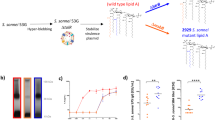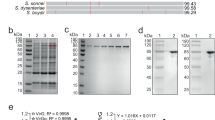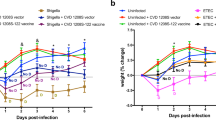Abstract
Shigella species cause severe bacillary dysentery in humans and are associated with high morbidity and mortality. The Invasion plasmid antigen (IpaB) protein, which is conserved across all Shigella spp., induces macrophage cell death and is required to invade host cells. The present study evaluates the immunogenicity and protective efficacy of the recombinant (r) domain region of IpaB (rIpaB) of S. flexneri. rIpaB was administered either alone or was co-administered with the rGroEL (heat shock protein 60) protein from S. Typhi as an adjuvant in a mouse model of intranasal immunization. The IpaB domain region (37 kDa) of S. flexneri was amplified from an invasion plasmid, cloned, expressed in BL21 Escherichia coli cells and purified. Immunization with the rIpaB domain alone stimulated both humoral and cell-mediated immune responses. Furthermore, robust antibody (IgG, IgA) and T-cell responses were induced when the rIpaB domain was co-administered with rGroEL. Antibody isotyping revealed higher IgG1 and IgG2a antibody titers and increased interferon-gamma (IFN-γ) secretion in the co-administered group. Immunization of mice with the rIpaB domain alone protected 60%–70% of the mice from lethal infection by S. flexneri, S. boydii and S. sonnei, whereas co-administration with rGroEL increased the protective efficacy to 80%–85%. Organ burden and histopathological studies also revealed a significant reduction in lung infection in the co-immunized mice compared with mice immunized with the rIpaB domain alone. This study emphasizes that the co-administration of the rIpaB domain and rGroEL protein improves immune responses in mice and increases protective efficacy against Shigella infection. This is also the first report to evaluate the potential of the GroEL (Hsp 60) protein of S. Typhi as an adjuvant molecule, thereby overcoming the need for commercial adjuvants.
This is a preview of subscription content, access via your institution
Access options
Subscribe to this journal
Receive 12 digital issues and online access to articles
$119.00 per year
only $9.92 per issue
Buy this article
- Purchase on Springer Link
- Instant access to full article PDF
Prices may be subject to local taxes which are calculated during checkout






Similar content being viewed by others
References
Kotloff KL, Winickoff JP, Ivanoff B, Clemens JD, Swerdlow DL, Sansonetti PJ et al. Global burden of Shigella infections: implications for vaccine development and implementation of control strategies. Bull World Health Organ 1999; 77: 651–666.
Philpott DJ, Edgeworth JD, Sansonetti PJ . The pathogenesis of Shigella flexneri infection: lessons from in vitro and in vivo studies. Philos Trans R Soc Lond 2000; 355: 575–586.
Sansonetti PJ . Microbes and microbial toxins: paradigms for microbial–mucosal interactions III. Shigellosis: from symptoms to molecular pathogenesis. Am J Physiol Gastrointest Liver Physiol 2001; 280: G319–G323.
Torres AG . Current aspects of Shigella pathogenesis. Rev Latinoam Microbiol 2004; 46: 89–97.
WHO. WHO Initiative for Vaccine Research (IVR). Geneva: WHO, 2006.
Menard R, Sansonetti PJ, Parsot C . Nonpolar mutagenesis of the ipa genes defines IpaB, IpaC and IpaD as effectors of Shigella flexneri entry into epithelial cells. J Bacteriol 1993; 175: 5899–5906.
Jennison AV, Verma NK . Shigella flexneri infection: pathogenesis and vaccine development. FEMS Microbiol Rev 2004; 28: 43–58.
Oaks EV, Hale TL, Formal SB . Serum immune response to Shigella protein antigens in rhesus monkeys and humans infected with Shigella spp. Infect Immun 1986; 53: 57–63.
High N, Mounier J, Prevost MC, Sansonetti PJ . IpaB of Shigella flexneri causes entry into epithelial cells and escape from the phagocytic vacuole. EMBO J 1992; 11: 1991–1999.
Blocker A, Gounon P, Larquet E, Niebuhr K . The Tripartite Type III Secreton of Shigella flexneri inserts IpaB and IpaC into host membranes. J Cell Biol 1999; 147: 683–693.
Menard R, Prevost M, Gounon P, Sansonetti P, Dehio C . The secreted Ipa complex of Shigella flexneri promotes entry into mammalian cells. Proc Natl Acad Sci USA 1996; 93: 1254–1258.
Schroeder GN, Hilbi H . Molecular pathogenesis of Shigella spp.: controlling host cell signaling, invasion, and death by type III secretion. Clin Microbiol Rev 2008; 21: 134–156.
Senerovic L, Tsunoda SP, Goosmann C, Brinkmann V, Zychlinsky A, Meissner F et al. Spontaneous formation of IpaB ion channels in host cell membranes reveals how Shigella induces pyroptosis in macrophages. Cell Death Dis 2012; 3: 1–10.
Turbyfill KS, Kaminski RW, Oaks EV . Immunogenicity and efficacy of highly purified invasin complex vaccine from Shigella flexneri 2a. Vaccine 2008; 26: 1353–1364.
Mills JA, Buysse JM, Oaks EV . Shigella flexneri invasion plasmid antigens B and C: epitope location and characterization with monoclonal antibodies. Infect Immun 1988; 56: 2933–2941.
Barzu S, Nato F, Rouyre S, Mazie J, Sansonetti P, Phalipon A . Characterization of B-cell epitopes on IpaB, an invasion-associated antigen of Shigella flexneri: identification of an immunodominant domain recognized during natural Infection. Infect Immun 1993; 61: 3825–3831.
Shen D, Saurya S, Wagner C, Nishioka H, Blocker AJ . Domains of the Shigella flexneri Type III Secretion System IpaB protein involved in secretion regulation. Infect Immun 2010; 78: 4999–5010.
Menard R, Sansonetti P, Parsot C, Vasselon T . Extracellular association and cytoplasmic partitioning of the IpaB and IpaC invasions of S. flexneri. Cell 1994; 79: 515–525.
Guichon A, Hersh D, Smith MR, Zychlinsky A . Structure–function analysis of the Shigella virulence factor IpaB. J Bacteriol 2001; 183: 1269–1276.
Martinez-Becerra FJ, Scobey M, Harrison K, Choudhari SP, Quick AM, Joshi SB et al. Parenteral immunization with IpaB/IpaD protects mice against lethal pulmonary infection by Shigella. Vaccine 2013; 31: 2667–2672.
Heine SJ, Diaz-McNair J, Martinez-Becerra FJ, Choudhari SP, Clements JD, Picking WL et al. Evaluation of immunogenicity and protective efficacy of orally delivered Shigella type III secretion system proteins IpaB and IpaD. Vaccine 2013; 31: 2919–2929.
Barta ML1, Dickenson NE, Patil M, Keightley A, Wyckoff GJ, Picking WD et al. The structures of coiled-coil domains from type III secretion system translocators reveal homology to pore-forming toxins. J Mol Biol 2012; 417: 395–405.
Veenendaal AK, Hodgkinson JL, Schwarzer L, Stabat D, Zenk SF, Blocker AJ . The type III secretion system needle tip complex mediates host cell sensing and translocon insertion. Mol Microbiol 2007; 63: 1719–1730.
Johnson S, Roversi P, Espina M, Olive A, Deane JE, Birket S et al. Self-chaperoning of the type III secretion system needle tip proteins IpaD and BipD. J Biol Chem 2007; 282: 4035–4044.
Stensrud KF, Adam PR, La Mar CD, Olive AJ, Lushington GH, Sudharsan R et al. Deoxycholate interacts with IpaD of Shigella flexneri in inducing the recruitment of IpaB to the type III secretion apparatus needle tip. J Biol Chem 2008; 283: 18646–18654.
Olive AJ, Kenjale R, Espina M, Moore DS, Picking WL, Picking WD . Bile salts stimulate recruitment of IpaB to the Shigella flexneri surface, where it colocalizes with IpaD at the tip of the type III secretion needle. Infect Immun 2007; 75: 2626–2629.
Kaufmann SH . Heat shock proteins and the immune response. Immunol Today 1990; 11: 129–136.
Zugel U, Kaufmann SH . Role of heat shock proteins in protection from and pathogenesis of infectious diseases. Clin Microbiol Rev 1999; 12: 19–39.
Lee JY, Yi NN, Kim US, Choi JS, Kim SJ, Choi JI . Porphyromonas gingivalis heat shock protein vaccine reduces vaccine reduces the alveolar bone loss induced by multiple periodontopathogenic bacteria. J Periodont Res 2006; 41: 10–14.
Gomez FJ, Allendoerfer R, Deepe GS . Vaccination with recombinant heat shock protein 60 from Histoplasma capsulatum protects mice against pulmonary histoplasmosis. Infect Immun 1995; 63: 2587–2595.
Wilhelm V, Zoza C, Martinez R, Rosemblatt M, Bursio LO, Valenzuela PD . Production and immune response of recombinant Hsp60 and Hsp70 from the salmon pathogen Piscirickettsia salmonis. Biol Res 2005; 38: 69–82.
Noll A, Autenreith IB . Immunity against Yersinia enterocolitica by vaccination with Yersinia hsp60 immunostimulating complexes or Yersinia hsp60 plus interleukin-12. Infect Immun 1996; 64: 2955–2961.
Lowrie DB, Silva CL, Colston MJ, Ragno S, Tascon RE . Protection against tuberculosis by a plasmid DNA vaccine. Vaccine 1997; 15: 834–838.
Ferrero RL, Thilberge JM, Kansau I, Wuscher N, Huerre M, Labigne A . The GroES homolog of Helicobacter pylori confers protective immunity against mucosal infection in mice. Proc Natl Acad Sci USA 1995; 92: 6499–6503.
Segal BH, Wang XY, Dennis CG, Youn R, Repasky EA, Manjili MH et al. Heat shock proteins as vaccine adjuvants in infections and cancer. Drug Discov Today 2006; 11: 534–540
Sagi SSK, Paliwal P, Bansal A, Mishra C, Khan N, Mustoori SR et al. Studies on immunogenicity and protective efficacy of DnaJ of Salmonella Typhi against lethal infection by Salmonella Typhimurium in mice. Vaccine 2006; 24: 7135–7141.
Paliwal PK, Bansal A, Sagi SSK, Sairam M, Govindaswamy I . Cloning, expression and characterization of heat shock protein 60 (GroEL) of Salmonella enteric serovar Typhi and its role in protective immunity against lethal Salmonella infection in mice. Clin Immunol 2008; 126: 89–96.
Bansal A, Paliwal PK, Sagi SS, Sairam M . Effect of adjuvants on immune response and protective immunity elicited by recombinant Hsp60 (GroEL) of Salmonella Typhi against S. Typhi infection. Mol Cell Biochem 2010; 337: 213–221.
Paliwal PK, Bansal A, Sagi SS, Sairam M . Intraperitonial immunization of recombinant Hsp 70 (DnaK) of Salmonella Typhi induces a predominant Th2 response and protective immunity in mice against lethal Salmonella infection. Vaccine 2011; 29: 6532–6539.
Chitradevi ST, Kaur G, Singh K, Sugadev R, Bansal A . Recombinant Heat shock protein 60 (Hsp60/GroEL) of Salmonella enterica serovar Typhi elicits cross-protection against multiple bacterial pathogens in mice. Vaccine 2013; 31: 2035–2041.
Triglia RP, Linscott WD . Titers of nine complement components, conglutinin and C3b-inactivator in adult and fetal bovine sera. Mol Immunol 1980; 17: 741–748.
Taylor DN . The growing problem of antimicrobial resistance among enteric pathogens. Clin Updates Infect Dis 2003; 6: 1–4.
Dutta D, Bhattacharya MK, Dutta S, Datta A, Sarkar D, Bhandari B et al. Emergence of multidrug-resistant Shigella dysenteriae Type 1 causing sporadic outbreak in and around Kolkata, India. J Health Popul Nutr 2003; 21: 79–80.
Seidlein LV, Kim DR, Ali M, Lee H, Wang X, Thiem VD et al. A multicentre study of Shigella diarrhoea in six asian countries: Disease burden, clinical manifestations, and microbiology. PLoS Med 2006; 3: 1556–1569.
Pazhani GP, Niyogi SK, Singh AK, Sen B, Taneja N, Kundu M et al. Molecular characterization of multidrug-resistant Shigella species isolated from epidemic and endemic cases of shigellosis in India. J Med Microbiol 2008; 57: 856–863.
Antoine B, Adjehi D, Nathalie G, Valerie G . Virulence factors and resistance profile of Shigella isolated during infectious diarrhea in Abidjan, Cote D'Ivoire. J Appl Sci Res 2010; 5: 594–599.
Kweon M . Shigellosis: the current status of vaccine development. Curr Opin Infect Dis 2008; 21: 313–318.
Ogra PL, Faden H, Welliver RC . Vaccination strategies for mucosal immune responses. Clin Microbiol Rev 2001; 14: 430–445.
Rasolofo-Razanamparany V, Cassel-Beraud AM, Roux J, Sansonetti PJ, Phalipon A . Predominance of serotype-specific mucosal antibody response in Shigella flexneri-infected humans living in an area of endemicity. Infect Immun 2001; 69: 5230–5234.
Finkelmen FD, Katona IM, Mosmann TR, Coffman RL . Interferon γ regulates the isotypes of immunoglobulin secreted during in vivo humoral responses. J Immunol 1988; 140: 1022–1027.
Le- Barillec K, Magalhaes JG, Corcuff E, Thuizat A, Sansonetti PJ, Phalipon A . Roles for T and NK cells in the innate immune response to Shigella flexneri. J Immunol 2005; 175: 1735–1740.
Jehl SP, Nogueira CV, Zhang X, Starnbach MN . IFN γ inhibits the cytosolic replication of Shigella flexneri via the cytoplasmic RNA sensor RIG-I. PLoS Pathog 2012; 8: e1002809.
Way SS, Borczuk AC, Dominitz R, Goldberg MB . An essential role for Gamma interferon in innate resistance to Shigella flexneri infection. Infect Immun 1998; 66: 1342–1348.
Raqib R, Ljungdahl A, Lindberg AA, Andersson U, Andersson J . Local entrapment of interferon-gamma in the recovery from Shigella dysenteriae type 1 infection. Gut 1996; 38: 328–336.
Martinez-Becerra FJ, Kissmann JM, Diaz-McNair J, Choudhari SP, Quick AM, Mellado-Sanchez G et al. Broadly protective Shigella vaccine based on type III secretion apparatus proteins. Infect Immun 2012; 80: 1222–1231.
Martinez-Becerra FJ, Chen X, Dickenson NE, Choudhari SP, Harrison K, Clements JD et al. Characterization of a novel fusion protein from IpaB and IpaD of Shigella spp. and its potential as a pan-Shigella vaccine. Infect Immun 2013; 81: 4470–4477.
Heine SJ, Diaz-McNair J, Andar AU, Drachenberg CB, van de Verg L, Walker R et al. Intradermal delivery of Shigella IpaB and IpaD type III secretion proteins: kinetics of cell recruitment and antigen uptake, mucosal and systemic immunity, and protection across serotypes. J Immunol 2014; 192: 1630–1640.
Kurella S, Monacha M, Sabhnani L, Thomas B, Rao DN . New age adjuvants and delivery systems for subunit vaccines. Indian J Clin Biochem 2000; 15: 83–100.
Acknowledgements
We would like to thank Mr Bhagwat Singh of the Experimental Animal Facility for his valuable support and technical assistance with animal handling. Ms S T S Chitradevi thankfully acknowledges the financial assistance provided by the Defence Research and Development Organization. This work was supported by the Defence Research and Development Organization, Ministry of Defence, Government of India. There are no conflicts of interest for the authors to report.
Author information
Authors and Affiliations
Corresponding author
Rights and permissions
About this article
Cite this article
Chitradevi, S., Kaur, G., Uppalapati, S. et al. Co-administration of rIpaB domain of Shigella with rGroEL of S. Typhi enhances the immune responses and protective efficacy against Shigella infection. Cell Mol Immunol 12, 757–767 (2015). https://doi.org/10.1038/cmi.2014.86
Received:
Revised:
Accepted:
Published:
Issue Date:
DOI: https://doi.org/10.1038/cmi.2014.86
Keywords
This article is cited by
-
Facile synthesis of multi-faceted, biomimetic and cross-protective nanoparticle-based vaccines for drug-resistant Shigella: a flexible platform technology
Journal of Nanobiotechnology (2023)
-
Efficient production of immunologically active Shigella invasion plasmid antigens IpaB and IpaH using a cell-free expression system
Applied Microbiology and Biotechnology (2022)
-
In-silico design and production of a novel antigenic chimeric Shigella IpaB fused to C-terminal of Clostridium perfringens enterotoxin
Molecular Biology Reports (2019)



